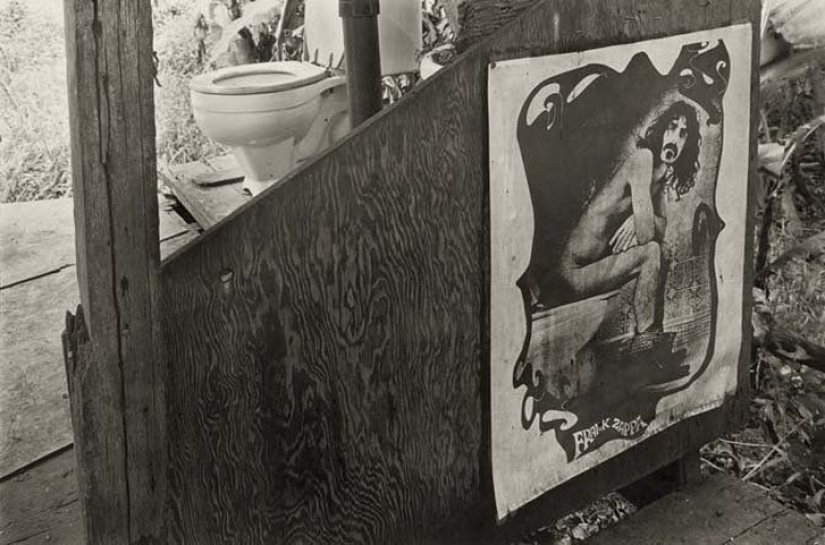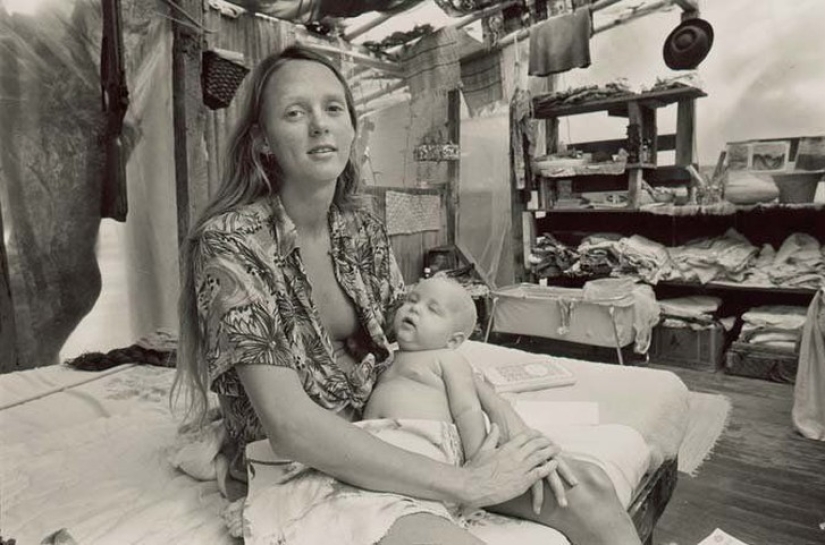Lost Paradise: Hippie Camp in Hawaii
Camp Taylor was located on the edge of the earth, in a tropical utopia, on the ocean, without rules, policies or bill payments. An anti-society where everything is different, where clothes were optional and where decisions were made in accordance with the "vibrations" of the soul or body. It was a miracle, a fantasy of flower children come true.
(19 photos in total)
 Source: LiveJournal/shri-boomer
Source: LiveJournal/shri-boomer

1. Camp Taylor began its life in the spring of 1969 with thirteen hippies seeking refuge from the then riots in the United States and police brutality. After running away from home, they headed to the island of Kauai in Hawaii. It was a very remote and virgin land, on which, of all the benefits of civilization, there was only one lighthouse.

2. "We were members of the anti-war movement, and there was so much violence in Berkeley that it was ready to explode. There were only two options: either take up arms or flee the city," recalls Sandra Schaub, one of the founders of Camp Taylor, who fled to Hawaii with her husband Victor. "So we decided to go to Europe at first, but then the thought came to us: "Oh, damn, we've never been to Hawaii." At that moment, we could have gone to Hawaii, and Asia, and Europe, even to hell in the middle of nowhere. We had no idea what to do."
Without any means of livelihood, homeless and not interested in any kind of standard lifestyle, at the time when the hippie tribe was persecuted and imprisoned for vagrancy, they were finally desperate.
But they could hardly have thought that one of the most famous families in Hollywood would come to their aid. Howard Taylor, Elizabeth Taylor's brother, who was a resident on the island, rescued them and invited them to live rent-free on his land, in one of the most beautiful places on the island, where the untouched beauty of the tropical jungle flowed into the crystal clear Blue Bay.

3. These photos were taken by a resident of Camp Taylor, John Weirheim. Next you will see excerpts from his photo album.

4. There was no electricity, no sewerage, no amenities of any kind, and when Howard Taylor was the first on the island, he built his bungalow out of bamboo, strengthening it on trees. When several families gathered here at the Flower Power camp, they began to realize their utopian dream without any restrictions and controls.

5. They lived off the land, fishing and fruit picking. Sometimes there was a medic or a midwife in the camp… The fame of the Hippie Village spread further and further, and more and more hippies, surfers and Vietnam War veterans came here to start a new life in this anarchic community.

6.

7.

8. Everyone went naked, and tourists tried not to ask unnecessary questions. Former Taylor Camp resident Rosie Rosenthal, today an ESPN radio host and special assistant to the mayor on the Big Island, recalls the atmosphere of that time like this:
"We were naked because we wanted to feel like children in the bosom of nature. Everyone thinks that nudity cultivates lust. They, you know, constantly have one thought that we are here almost daily indulging in sin. Oh, oh, oh, isn't that right?"

9. "But when you live naked, you will realize that these naked girls you see every day will become your sisters. There are no lustful desires. It's like walking with your family. We were hippies. I've never heard of any orgies, and if I had known about them, I would have been there. If you know what I mean. It didn't happen, but then I wouldn't be shy about this kind of thing. And we had mostly married couples. Relationships and sex? Yes, they were, but wild orgies were not a common thing. The relationship was like in any middle class of society."

10. At the peak of settlement development, about 120 people lived in the camp, occupying 7 acres of land. Residents accepted any strangers who were on the run or looking for a break.

11.

12. "We didn't need television; we knew what was going on," says Sandra Schaub. — We lived side by side with veterans of the Vietnam War. They came back and they were crippled. Can you tell the difference between guys who served and guys who didn't fight? The boys who went through the Vietnam War could no longer smile, and we had to teach them how to do it again."

13. Marijuana and psychedelic drugs were, of course, part of the live experience for many residents of Camp Taylor. Sisters Teri and Debbie Green, known throughout the camp as the "sin sisters," are now living a normal life in San Francisco. At the same time, they were constantly using LSD. They recall another hippie girl who took this drug more than 300 times while living in the camp. Today she works as a lawyer.

14. "You needed some kind of sanity center, some kind of focus, and not just running around and banging bongos on the beach under the moon," says Teri. — It worked for some people, and it's absolutely true. For me, LSD was a tool, it was a spiritual awakening, an expansion of consciousness, which is used with a certain emphasis and for a certain purpose. It wasn't just "Lets party, break out the acid!""

15. But sooner or later all good things come to an end. Because behind every paradise comes the dark side in the end…
Hamilton raised several children on the island with his first wife Suzanne "Bobo" Rollin and his second girlfriend named Sherry, who arrived later (in the photo above, she feeds a baby on the beach).
Hamilton recalls: "Taylor's camp was pretty innocent, but there were also unpleasant moments. We had to somehow protect our cloudless existence. One night a guy wandered into the camp, and I woke up because I felt the cold of gun steel on my chest:
— Hey, asshole, do you have drugs? the stranger asked. I saw a hunting rifle in his hands. —Yes,— I replied and, turning away, reached into the bag. I pulled out a gun and pointed it straight at his forehead. "If you don't get out, bitch, I'll shoot you," I shouted, and the stranger immediately retreated.
We had a shack in the distance where the bad guys lived. One of the guys was called Roger the Dodger. The other was called Smiley. They were the bad guys. We kind of let them be there so they wouldn't bother us, but we got rid of their importunity after a year or two. Camp Taylor saw various guests, but mostly they were kind people."

16.

17. After eight years of living without rules and rulers, the story of Camp Taylor has come to an end. Hawaiians ran out of patience, they were strangled by the toad that some fucking hippies live rent-free in one of the most beautiful places on the island. The tourism industry was booming, and Camp Taylor was considered an eyesore. Complaints about nudity, drugs, unsanitary conditions and even theft sounded louder and louder until the hippie's luck ran out.

18. In 1977, the state bought this land from Mr. Taylor. The village was to be demolished to make way for Pali State Park Na, and all residents were evicted. The authorities set fire to the camp so that the hippies would never return. On the site of the village today there is a tourist parking lot equipped with picnic tables and public toilets.
Four decades later, former camp resident John Wehreim posted black-and-white photos he took while living at Camp Taylor.
This interested the directors Robert S. Stone and Thomas Vendetti. Driven by imagination, together they decided to trace the fate of former islanders, their neighbors and even government officials who eventually got rid of the hippies. In 2010, they made a documentary.
"I would say about 97 percent of the former settlers believed that the time spent in the camp was the best time of their lives," says co—producer Robert S. Stone. "I think the whole point is that the feeling of freedom, youth, vitality and connection with nature and like-minded people had a huge impact on the lives of these people."

19. "If I could go back, I'd like to go back there right now," said David Pearson, a surfer who arrived at Camp Taylor in 1972. He is currently a 67-year-old retired public school teacher on the Big Island. "I can't remember or even imagine anything cleaner and more beautiful than living there. It was the most defining experience of my life."
Keywords: 18+ | Hawaii | Camp | Paradise | Hippie
Post News ArticleRecent articles

In Ancient Egypt, gods were revered, pharaohs were glorified, and majestic tombs were built. The builders of royal tombs were ...

Whether you are a tourist or a professional photographer, in both cases Lapland is a truly magical place. There is not only a very ...
Related articles

On the eve of the New Year, a magical atmosphere reigns in every house — everything is hung with shiny tinsel, there is an ...

Soon the New year, which means it's time to review Christmas movies, buying gifts, planning the celebration and decorate their ...

American artist Lee Price is sure that eating is a completely natural process, but many are ashamed of their attitude to food, ...

Why should a coffin be a boring box if it can be ordered in the form of a lobster, fruit, bird or shoe? Residents of the African ...